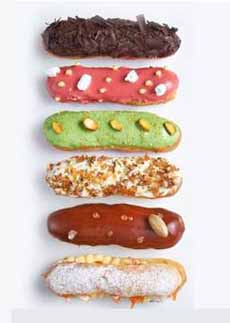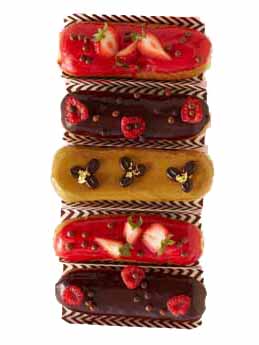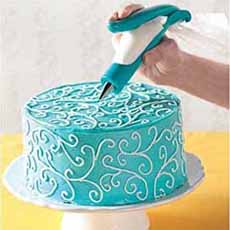TIP OF THE DAY: DIY Éclair Party

|
Éclairs are a special-occasion pastry. Only sugar-avoiders would turn down the opportunity to enjoy them.
Yet, the elongated pastry with the shiny chocolate or caramel top can be even more exciting. Just look at the photos, to see what great pastry chefs do with them. While it takes some skill to make attractive éclairs, its pretty easy to decorate ones you purchase. You’ll find the classic chocolate and caramel toppings, but may also find a rainbow of colors and flavors: coffee, currant (pink), dulce de leche, lemon, mango, matcha, pistachio, raspberry You can make a DIY party of it. You can make it a Mother’s Day (or other celebration) event. The history of the éclair is below. DECORATIONS Since the glaze (shiny icing) on top of the éclair will be set, you need a bit of something to adhere the decorations, plus utensils or squeeze bottles to dab them on. An elongated, finger-shaped pastry made of pâte à choux (puff pastry), filled with whipped cream or custard and topped with a glacé icing (glaze), the éclair originated in France around the turn of the 19th century. |
|
|
Éclair is the French word for lightning. Food historians believe that the pastry received its name because it glistens when coated with the glaze. We might suggest that it is because they are so popular that they disappear as quickly as lightning. The Oxford English Dictionary traces the word “éclair” in the English language to the second half of the 19th century: 1861. In the U.S., the first printed recipe for éclairs appears even later, in the 1884 edition of the Boston Cooking-School Cook Book, edited by Mrs. D.A. Lincoln (later editions were under the auspices of Fanny Farmer). Many food historians speculate that éclairs were first made by Marie-Antoine Carême (1874-1833). This brilliant man, cast out to make his own way at the age of 10 by his impoverished family, became the first “celebrity chef,” working for luminaries: Charles, Prince Talleyrand, the French ambassador to Britain; the future George IV of England; Emperor Alexander I of Russia and Baron James de Rothschild. The elite clamored for invitations to dinners cooked by Carême. He is considered to be the founder and architect of French haute cuisine; an innovator of cuisine, both visually (he studied architectural to create amazing presentations) and functionally (modern mayonnaise, for example). He also was an enormously popular cookbook author—an big achievement for a boy who had no education, yet taught himself to read and write. We can only dream…and live vicariously by reading his biography.
|
||

